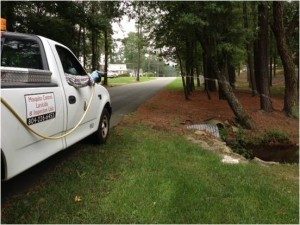Treatment and Pesticides
To help control mosquito populations, the Standing Water Initiative uses an Integrated Pest Management (IPM) approach which includes surveillance, source reduction and larviciding. Mosquitoes can be prevented by eliminating standing water (source reduction) or by treating aquatic sites with environmentally friendly larvicides (insecticides designed to kill mosquito larvae). Larviciding is the process of controlling mosquitoes when they are in the water as larvae. We do not currently conduct adulticide operations.
Standing Water Initiative employees inspect and treat standing water on county property to control mosquito larvae throughout the spring, summer and fall. Our control efforts are focused on eliminating mosquitoes in the larval stage. We use a truck-mounted liquid larvicide applicator to treat county-owned mosquito breeding sites, such as roadside drainage ditches, flooded wetland areas, and underground storm water pipes. Smaller areas are usually treated by hand with a granular form of larvicide. Our larvicide treatments are based on field surveillance to ensure we are targeting areas in need of control and not applying larvicides where it is not necessary.
There are a number of different products available for mosquito larval control and often times, one product will be better suited for a particular mosquito breeding site than another product. Listed below are the common larvicides (active ingredients) we use:
Bti – Bacillus thuringiensis israelensis (Bti) is a naturally occurring soil bacterium. Susceptible mosquito larvae species eat the Bti product and the toxin disrupts the gut in the mosquito. Larvae become sluggish and die within 24 hours.
B-sphaericus – Bacillus sphaericus is a naturally occurring soil bacterium very similar to Bti. Mosquito larvae of susceptible species ingest a lethal dose of B. sphaericus crystals and spores. Toxins are released in the larva’s gut, paralyzing and damaging the digestive system. The larvae become sluggish and die within 48 hours
Spinosad – Spinosad is also a naturally occurring soil microorganism. It is ingested by the susceptible mosquito larvae species, resulting in rapid excitation of the insect nervous system.
Methoprene – Methoprene is an insect growth regulator (IGR) that interferes with normal mosquito development. Methoprene is absorbed through the skin of the larvae and disrupts the normal development cycle resulting in the inability to complete their metamorphosis.
Additional information about pesticides used for mosquito control may be found on USEPA’s Larvicides for Mosquito Control Web page.





